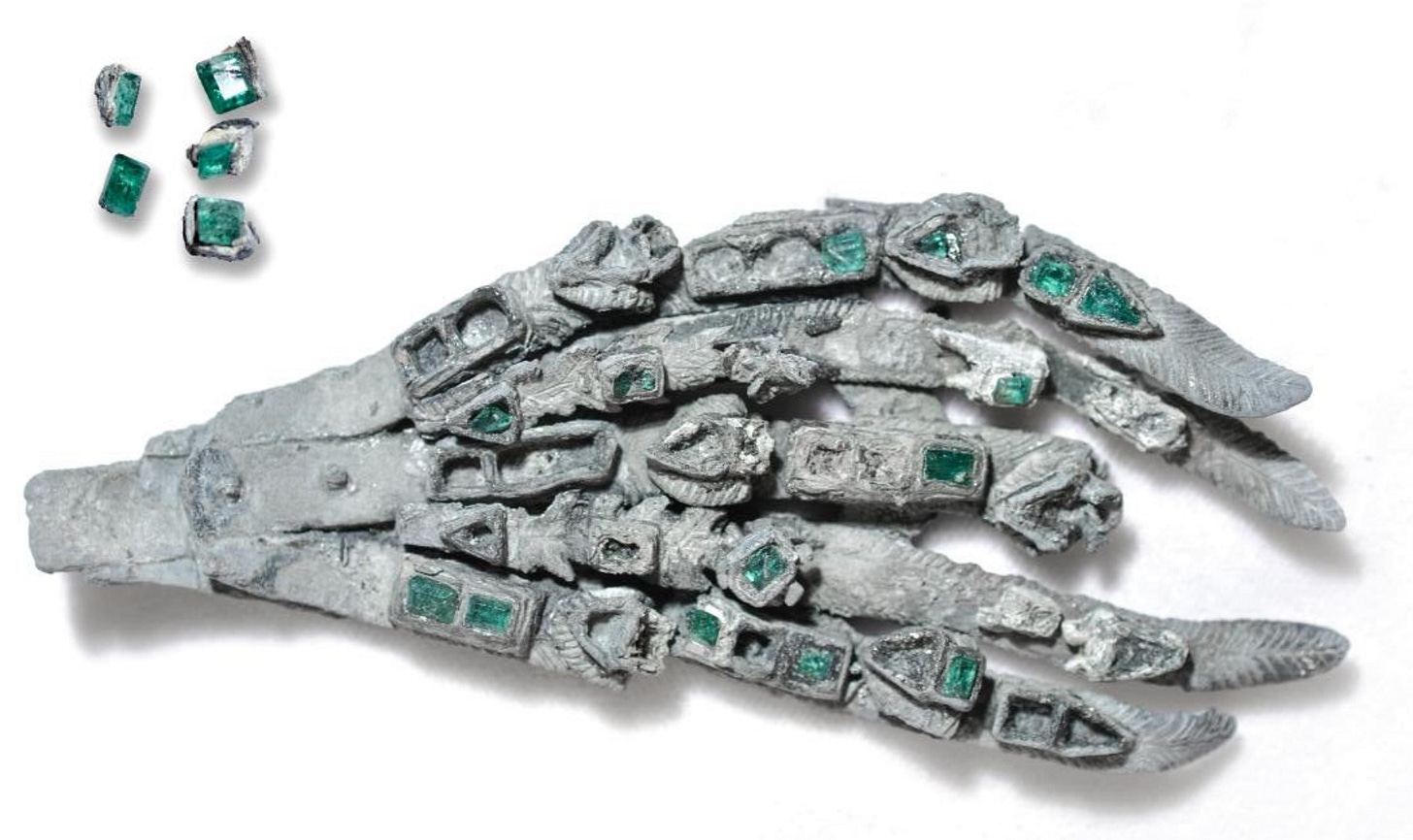
This past Friday marked the 10th anniversary of the discovery of the Staffordshire Hoard, the largest hoard of Anglo-Saxon treasure ever found. Consisting of nearly 4,000 items, the pieces are entirely military-related. No jewelry or coins or domestic items are included, but the pieces are still beautifully crafted of gold and silver, and many are inlaid with specially-cut garnet accent stones or feature extremely fine filigree work. According to the excellent dedicated website, they were made in the 6th and 7th century AD and buried in the mid 7th century (650-675 AD). They’re now on display at two museums — the Birmingham Museum and Art Gallery and the Potteries Museum and Art Gallery.
The hoard was discovered by a metal detectorist who was searching a field near the village of Hammerwich, near Lichfield, in Staffordshire, England. This area was originally the seat of the Anglo-Saxon kingdom of Mercia, which, according to the Birmingham Museum, was “militarily aggressive and expansionist during the seventh century, under kings Penda, Wulfhere and Aethelred.”
The pieces in the hoard are of the highest quality and craftsmanship, so they’re believed to have belonged to high-ranking soldiers or the aristocracy. A third of the fragments in the hoard were originally part of an extremely fancy gold helmet, and some of the pieces may also be battle trophies — there are over 90 sword pommel caps (the tip of the sword hilt that anchors it to the blade) that were clearly ripped from their original swords.
There’s also a strip of silver gilt metal (pictured above) that may have been part of a reliquary or Bible cover that features an inscribed Biblical verse in Latin (with two misspellings!) that says “rise up, o Lord, and may thy enemies be scattered and those who hate thee be driven from thy face.” That strip and two crosses make up the only religious items in the hoard.
Interestingly, many of the pieces (including one of the crosses) in the hoard were damaged prior to burial — they were deliberately bent or folded, possibly so they would fit into a smaller space. And experts are baffled as to who buried the hoard and why — was it Christians or pagans? Spoils of war or simply buried treasure? It’s still a huge mystery. The hoard website offers these words from Beowulf:
One warrior stripped the other, looted Ongentheow’s iron mail-coat, his hard sword-hilt, his helmet too, and carried graith to King Hygelac; he accepted the prize, promised fairly that reward would come, and kept his word. They let the ground keep that ancestral treasure, gold under gravel, gone to earth, as useless to men now as it ever was.
In 2012, the field where the hoard was found was replowed and another 81 pieces were unearthed. In total, the hoard was valued at £3.285 million and jointly purchased by the Birmingham and Stoke-on-Trent City Councils. The detectorist and the owner of the field split the money, and no longer speak to each other.
If you want to read more, there’s a great article here from National Geographic.
Oh and this is unrelated, but while I have you here — if you haven’t watched Detectorists yet, please do. It’s about as quietly perfect as a tv show can be.

Circa the 1880s, a gorgeous niello bangle with a buckle motif.
Niello is a deep black or gray metal amalgam that is fused onto another (usually lighter-colored) metal to create a decorative pattern or background. The technique — which goes back at least as far as the ancient Egyptians and possibly even earlier — involves incising a design into metal and then filling the carved recess with the niello alloy in powder or paste form. The piece is then heated (to harden the niello) and polished to bring out the contrasting shades of metal.
This bracelet is silver, with a background of deep gray niello emphasizing a contrasting pattern of teeny tiny stars (with some stripes on the buckle). Gorgeous.
[Side note: The strip of Staffordshire Hoard silver gilt mentioned above, with the Biblical inscription about scattering thy enemies? The main inscription was also done in niello.]

Not old, but I dunno, seems timely.

Next week, Guernsey’s is presenting “A Century at Sea,” a two-day-long maritime auction in Newport, RI. The sale is loaded with interesting, unusual items, including artifacts from famous ships like the Lusitania and the Andrea Doria, as well as posters, ship models, menus, match tins and compacts (I actually have my eye on these) and tons more. There’s also a porthole from the wreck of the Canadian ocean liner RMS Empress of Ireland, which sank in a boat collision on the Saint Lawrence River in 1914, as well as an illuminated cane that was used by one of the survivors of the Titanic and mentioned in the book A Night to Remember by Walter Lord.
Above is a wing-shaped piece of jewelry featuring Colombian emeralds set in lead. It was recovered from the wreck of the Spanish treasure galleon Nuestra Señora de Atocha, which sank during a hurricane near the Florida Keys in 1622 and was discovered by American treasure hunter Mel Fisher in 1985. The Atocha was estimated to have between sixty and seventy pounds of emeralds on board when it sank, including the Atocha Star emerald, which weighed in at 25.87 carats when recovered by Fisher. Only 10% of the emeralds have been recovered, and overall, only around half of the Atocha treasure has been found so far.
Ok, that’s enough randomness for now. Happy Wednesday, everybody! xx



